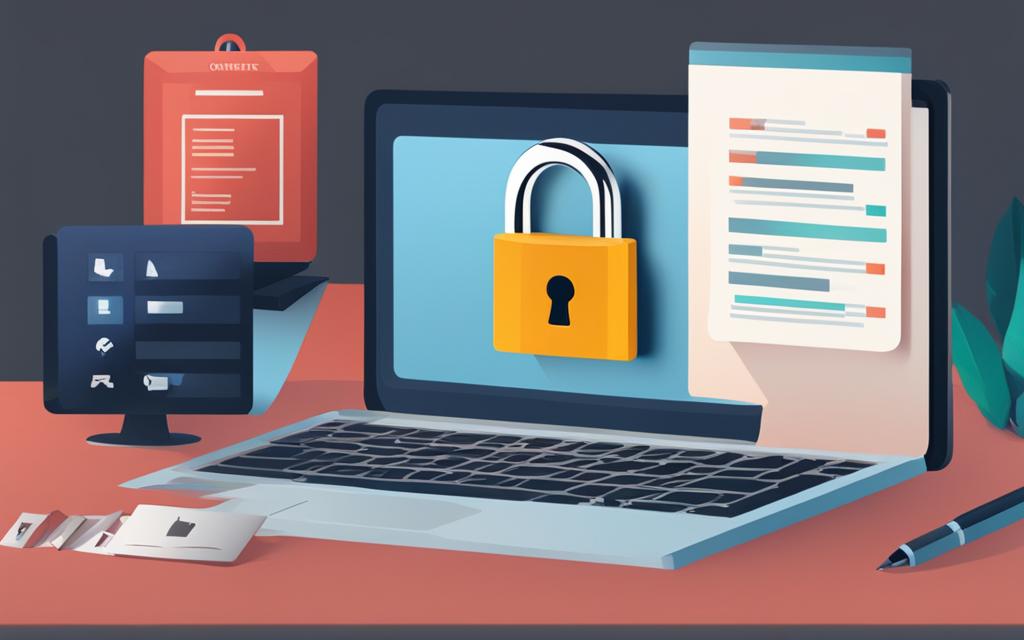In today’s digital age, the security of your online accounts is more crucial than ever. With the increasing prevalence of cyber threats, it’s essential to take proactive measures to protect your digital assets. Creating and managing a secure online password vault is one of the most effective ways to ensure online password security and secure password storage.
In this comprehensive guide, you’ll learn how to create and manage a secure online password vault to protect your online accounts. Following password management best practices and implementing robust security measures will give you the peace of mind that your online accounts are secure.
Understanding the Importance of Secure Password Storage
Before you dive into creating a secure online password vault, you must realize the importance of password protection. With hackers increasingly targeting online accounts, it’s essential to have secure password storage to protect your digital assets. Using weak passwords or reusing the same password across multiple accounts can make you vulnerable to cyber-attacks.
Online password security is crucial as you never know when a data breach may occur. Cybercriminals use sophisticated techniques to access passwords stored insecurely and use them to steal sensitive information. Secure password storage can help prevent these data breaches and safeguard your online accounts from unauthorized access.
So, what exactly is secure password storage? It means storing passwords securely in an encrypted password vault that is protected by a strong master password. A password manager allows you to store all your passwords in one place, making it easier to manage them effectively. The password manager automatically generates complex passwords, making it harder for hackers to guess them.
Choosing the Right Password Vault Creation Method
When creating a password vault, it’s crucial to select the right method that ensures secure password storage. Here are some methods you can consider:
1. Using a built-in password manager
Many web browsers and operating systems come with built-in password managers that can create and store passwords for you. While convenient, these password managers may not always provide the best level of security, and you may not have full control over your passwords. It’s essential to research the security features of your chosen browser or operating system to ensure they meet your security requirements.
2. Installing a password manager app
Password manager apps like LastPass, Dashlane, and 1Password are popular for their robust security features and convenience. These apps can generate strong passwords, store them securely, and autofill them when needed. However, using a third-party app comes with its own risks, such as potential security vulnerabilities or data breaches. It’s crucial to research and select a reputable password manager app with a strong track record.
3. Creating a custom password vault
If you want full control over your password vault’s security, you can create a custom password vault using software like KeePass or Bitwarden. These applications allow you to create a password database on your device, which you fully control. However, creating a custom password vault requires technical knowledge and expertise, and you must ensure to follow password management best practices to keep it secure.
No matter which method you choose, make sure to use a strong master password, enable two-factor authentication if possible, and back up your password vault regularly.
Implementing Password Management Best Practices
Creating a secure password vault is only half the battle in achieving maximum password protection. To ensure the safety of your digital assets, you must also implement password management best practices in your daily routine. Here are some essential tips:
- Create Strong Passwords: Use a combination of upper and lowercase letters, numbers, and symbols to create complex and unique passwords for each account. Avoid using personal information or easily guessable words.
- Avoid Password Reuse: Never reuse the same password across multiple accounts, as this can easily compromise all of your accounts if one password is compromised.
- Use Two-Factor Authentication: Two-factor authentication provides an additional layer of security to your accounts by requiring a code from a separate device or app to login. Enable two-factor authentication whenever possible for maximum security.
- Regularly Update Passwords: Set a schedule to regularly update your passwords, ideally every three to six months. This will ensure that even if a password is compromised, it will only be valid for a limited time.
- Use a Password Manager: Consider using a password manager to generate and store unique passwords for each account. A password manager can also help you keep track of password expiration dates and remind you when it’s time to update a password.
By following these password management best practices, you can significantly enhance the security of your online accounts. Remember, maintaining secure password storage is an ongoing process, and it’s essential to stay vigilant and proactive in protecting your digital assets.

Enhancing the Security of Your Password Vault
Creating a secure password vault is an essential step toward protecting your sensitive data. However, it’s crucial to enhance the security of your vault by implementing additional measures against cyber threats. Here are some practices to consider:
Two-Factor Authentication
Two-factor authentication (2FA) adds an extra layer of security to your password vault by requiring a secondary verification method in addition to your password. Online password security experts recommend using 2FA to protect your accounts from unauthorized access. You can enable 2FA on your vault by connecting it to an app on your smartphone or a security key.
Regular Software Updates
Regular software updates are vital for keeping your password vault secure. Software updates often include bug fixes and security patches that address known vulnerabilities. Make sure to check for and install updates regularly to ensure that your password vault is protected against the latest threats.
Strong Vault Password
The strength of your vault password is critical to its security. Be sure to create a strong, unique password for your vault that is difficult for others to guess. Your password should be at least 12 characters long and include a mix of uppercase and lowercase letters, numbers, and symbols. Consider using a password manager to generate and store a secure password for your vault.
Regularly Monitor Your Vault
Regularly checking your password vault for any irregularities or signs of unauthorized access is an important part of maintaining its security. Review your vault activity logs to ensure that there are no unauthorized logins or unusual activity that could signify a breach. If you notice any suspicious activity, take immediate action by changing your vault password and reviewing your account for any signs of unauthorized access.
By implementing these security measures, you can significantly enhance the security of your password vault and protect your sensitive data from cyber threats.
Managing and Organizing Passwords in Your Vault
Now that you have created a secure password vault, it’s time to manage and organize your passwords effectively. By doing so, you can ensure that your online accounts remain protected, and you can access them when needed. Here are some password vault management tips to follow:
- Create Categories: Consider creating different categories for your passwords, such as social media, banking, work, and personal accounts. This will help you locate and manage your passwords more efficiently.
- Use Descriptive Names: When saving a new password, use descriptive names that are easy to remember and recognize. This can be especially helpful if you have multiple accounts for the same service or website.
- Update Regularly: As part of your password management best practices, ensure that you are regularly updating your passwords, even if they have not been compromised. This can help prevent potential data breaches and unauthorized access.
- Secure Password Sharing: If you need to share a password with someone else, do so securely. Avoid sharing passwords via email or text message. Instead, use a secure password sharing tool or service that encrypts your password before sharing it.
Password Management Best Practices
In addition to managing your passwords in your vault, there are other best practices to follow to ensure your password security remains a top priority:
- Use Strong Passwords: Your passwords should be long, complex, and unique for each account. Use a mix of uppercase and lowercase letters, numbers, and symbols. Avoid using easily guessable information, such as your name or date of birth.
- Avoid Reusing Passwords: Never reuse the same password across multiple accounts. If one account is compromised, it could put all of your other accounts at risk.
- Enable Two-Factor Authentication: Two-factor authentication adds an extra layer of security to your accounts by requiring you to enter a unique code in addition to your password. Enable this feature whenever possible.
- Log Out After Use: When using a shared device or computer, always log out of your accounts when finished. This can help prevent unauthorized access to your accounts.

“Managing and organizing passwords within your vault is a crucial aspect of maintaining a secure online presence.”
By following these password management best practices and managing your passwords effectively in your vault, you can significantly enhance the security of your online accounts and protect your digital assets. Remember to also regularly update your passwords and enable additional security measures such as two-factor authentication whenever possible.
Managing and Updating Your Passwords: Best Practices and Tips
Managing and updating your passwords is an essential aspect of maintaining a secure password vault. Adhering to password management best practices and utilizing password vault tips will help ensure the utmost security for your online accounts. Here are some recommendations:
Create Strong and Unique Passwords
When creating passwords for your accounts, use a combination of upper and lowercase letters, numbers, and special characters. Avoid using personal information or common words as they are more prone to hacking attempts. Consider using a password generator to create unique and complex passwords.
Update Passwords Regularly
It’s essential to update your passwords regularly to reduce the risk of unauthorized access to your accounts. Consider updating every six months or whenever there has been a data breach of a service that you use.
Avoid Using the Same Password for Multiple Accounts
Using the same password for multiple accounts is not recommended as it can lead to a domino effect. If one account is compromised, all other accounts with the same password will be at risk. Use unique passwords for each account or utilize a password manager to generate and store them securely.
Enable Two-Factor Authentication
Two-factor authentication adds an extra layer of security to your accounts by requiring a verification code in addition to your password. This ensures that even if your password is compromised, a hacker would still need access to your phone or email to gain access to your account.
Keep Your Password Vault Up to Date
Keep your password vault updated with the latest version of the software to ensure maximum security. Regular updates often include security patches and bug fixes that address potential vulnerabilities.

Remember, managing and updating your passwords is an ongoing process. Staying vigilant and following best practices will help ensure the security of your online accounts and protect your digital assets.
Backing Up and Syncing Your Password Vault
With your password vault up and running, it’s crucial to ensure that it’s backed up and synced across your devices to avoid losing access to your passwords.
One of the easiest ways to back up your password vault is to use a cloud service provider such as Google Drive or Dropbox. These providers offer secure storage for your password vault and allow you to access it across multiple devices.
To back up your password vault, follow these simple steps:
- Open your password vault and go to the settings menu.
- Select the backup option and choose the cloud service provider you want to use.
- Follow the prompts to set up the backup and sync your password vault across your devices.
It’s also essential to regularly sync your password vault to ensure that any new passwords or changes you make are updated across all your devices.
Remember to keep your backup and sync options up to date, and ensure that your password vault is secure at all times.
Conclusion
Creating and managing a secure online password vault is crucial in protecting your digital assets from cyber threats. By implementing robust security measures and following password management best practices, you can significantly enhance the security of your online accounts and maintain peace of mind.
To ensure the utmost security, it’s essential to choose the right password vault creation method that best suits your security requirements. Once you have created your password vault, managing and organizing passwords within it is equally important. Regularly updating and changing your passwords, backing up and syncing your password vault, and implementing additional security measures are all fundamental aspects of password vault management.
By following the guidelines outlined in this guide, you can master the art of password vault creation and management and ensure secure password storage. Remember to keep your vault password safe and secure, and avoid sharing it with anyone.
Investing time and effort in creating and managing a secure password vault is worth it for the peace of mind it brings. Stay vigilant, stay secure, and enjoy hassle-free online password management.







